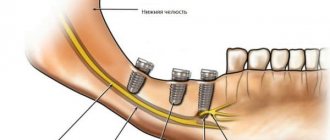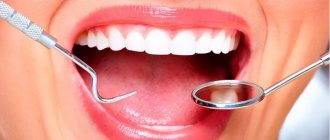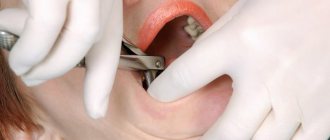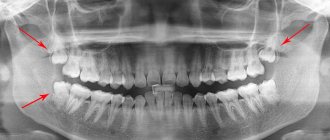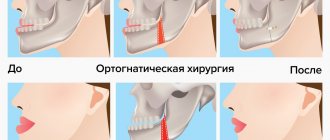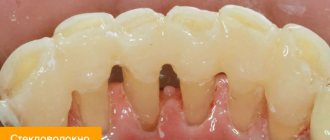Wisdom teeth removal with 20% discount
Moscow
15% of the world's population does not even have wisdom teeth. These lucky ones have no idea how much suffering and pain third molars or “eights” can cause. The vast majority will sooner or later have to face a serious dilemma: to remove or not to remove wisdom teeth. This happens between the ages of 18 and 25 – it is during this period that wisdom teeth begin to grow. In rare cases, an earlier or later appearance of eights is observed - at 15 - 16 years old or at 25 - 30 years old.
The opinions of American, European and Russian experts on this matter differ. If foreign dentists insist on the mandatory removal of third molars, then domestic dentists try to save the tooth. Therefore, if the doctor insists on removal, we can say unequivocally: there are good reasons for this!
And all the patient can do is mentally prepare for the procedure. Unfortunately, information openness in this regard is not always beneficial. Stories about torment in the dentist's chair are transmitted from one forum to another, acquiring more and more terrifying details. As a result: there is a myth about the incredible difficulty of removing wisdom teeth, and the unbearable pain that every patient will have to endure. But is this really so? And should I be afraid of removal?
Is it painful to remove a wisdom tooth from above?
The bone tissue of the upper jaw is not as dense as the tissue of the lower jaw. Additionally, superior figure eights typically have less tortuous roots than lower molars. Therefore, local anesthesia can completely relieve the patient of pain during surgery. This is confirmed by reviews of people who have already had an upper wisdom tooth pulled out. They note that the most unpleasant, but quite tolerable sensations were experienced when the anesthetic was administered. And the removal itself was absolutely painless.
It can really hurt those patients who put off visiting the doctor for a long time. And all this time they took painkillers. Local anesthesia also has a very bad effect on people who use drugs.
Hematoma after wisdom tooth removal –
This is a normal phenomenon, albeit an unpleasant one. This is due to the fact that some vessel in the soft tissues was injured. There is no point in blaming the doctor for this, since the doctor, when administering anesthesia, does not see where the vessels pass in your soft tissues. The needle can injure such a vessel. After a few days, the skin may appear blue. Gradually it will pass.
However, the formation of a hematoma may require additional measures. For example, already on this day or the next day after removal, the patient developed swelling of the cheek, a feeling of fullness, pain, and a slight fever. Such symptoms may also indicate the presence of a hematoma. You need to see a doctor; depending on the situation, you may need to take antibiotics, or make a loosening incision along the gum, or both.
If you experience such symptoms, then you should not postpone your visit to the dentist, because... in most cases, swelling and pain in this situation will only increase.
Is it painful to remove a wisdom tooth from below?
Reviews about the removal of lower wisdom teeth are very contradictory. Some talk about the complete painlessness of the operation, others remember the minutes spent in the chair with a shudder. The fact is that when a wisdom tooth is removed from below, the patient’s sensations directly depend on the professionalism of the doctor.
Thus, infiltration anesthesia in the upper jaw is carried out in the gum in the area of the root of the wisdom tooth. And in the case of the lower “eight”, the dentist has to give an injection from the inside of the jaw. Carrying out such anesthesia is technically more difficult, and, alas, not all dentists are fluent in it.
If modern anesthetics are used, and the doctor is a professional in his field, pain during the removal of the lower wisdom tooth is completely eliminated.
It may hurt a little when the anesthetic is administered. Unpleasant sensations do not go away if an abscess has already formed in the area of the wisdom tooth. But in particularly difficult cases, the dentist may decide to use general anesthesia.
Patient reviews
Review 1
Before describing the procedure, I want to talk about my pain threshold. I can NOT stand pain. At all! I LOVE IT!!! For example, before treating caries, I ask you to give me 2 painkiller injections. And then one day my wisdom tooth began to hurt. I endured it steadfastly! But patience has come to an end! I had to go to the clinic.
Sitting down in a chair, I, as usual, asked for 2 injections and mentally prepared myself for torture :) Instead of somehow supporting and encouraging me, the doctor said: - Nahhh... but the tooth is in an inaccessible place! You can’t even get close to him!!!
Then she asked me to open it wider, then even wider, then again and again... It seemed to me that the corners of my mouth were already torn, and the doctor kept asking me to make my “mouth wider”! At the same time, she said, “What can I do here...” and tried to pick up the tooth with pliers.. These attempts lasted about 5 minutes. There was no particular pain, it was just unpleasant that the doctor could not pick up the tooth and was scared from waiting for the outcome. In the end, I asked: - Maybe I’ll go already?!!! If she can’t pick up a tooth, then WHAT will happen next?! To my deep surprise, the doctor did not even try to persuade me to stay and complete the procedure. She simply said: “Go!”
Well, wow :) This has never happened to me before. Usually doctors persuade: - Well, be patient... If you came, then you need to be patient. And here on you - go... I ask: - And what to do now? The answer was: “Nothing!” Rinse! And don't eat anything for 2 hours. And don't drink anything hot all day. - Why??? - Because the wound should heal. - So you REMOVED my tooth??? - Yes!
Just like that! While I was preparing for “medieval torture” and many hours of torment, the specialist did her job! BRAVO!!! I was delighted! After a couple of hours, the freezing sensation began to subside and the pain returned. She was tolerable, rinsing helped. After a few days the pain went away, but the wound healed for probably a whole month! The pain was weak and dull... The gums ached a little and as if something was pulling. But everything ended well! Everything is overgrown evenly.
Review 2
One of the four teeth had grown into the gum and began to rot there. Therefore, when I came to my favorite dentist, there was only one diagnosis - the wisdom tooth needed to be removed. I honestly couldn’t even get scared when I was already given anesthesia and the fragile dentist started pulling my tooth.
From the sensations, I can’t say that it hurt, no, the anesthesia worked well, but there was a feeling, I felt the tooth being taken with forceps, how it was being pulled, and I was even surprised how my fragile doctor pulled out this chunky tooth. He fought hard to get out, but for professionals there are no problems.
After this, of course, my gums bled a little, I was prescribed mouth rinses so that everything would heal faster. My gums healed within a day. I did not feel any discomfort due to the missing wisdom tooth.
Therefore, I can say for sure that the devil is not as scary as he is painted. Yes, it was unpleasant, but not painful and it could be tolerated. And if I have to remove the rest of my wisdom teeth, I won’t be the least bit upset or scared. Since there is nothing scary in this procedure.
How long will an extracted tooth hurt?
Removing a wisdom tooth is a serious surgical procedure that severely injures the soft tissues of the periodontium. The fact is that third molars are large teeth, having from 2 to 5 roots. And after their removal, an open bleeding wound remains in the jawbone and gum, which will definitely hurt. And not a couple of hours, but several days.
The pain can be aching and cutting, radiating to the throat or ear. The patient may complain of painful swallowing and persistent headache. An increase in body temperature to 37.5 0C is also natural and physiological. There is no need to endure unpleasant sensations. After tooth extraction, the dentist will definitely recommend painkillers:
- paracetamol;
- ibuprofen;
- analgin;
- butadione;
- sedalgin.
All of them are available without a prescription, are not addictive and have minimal side effects. At the same time, they effectively relieve pain. Normally, the pain at the site of the extracted tooth subsides within 3-7 days. And the final healing of the hole occurs by the end of 2 - 3 weeks after tooth extraction. During this time, she needs to be protected from injury - brush her teeth carefully, eat food carefully.
The appearance of edema is also natural after the removal of the figure eight. As a rule, it forms during the first day after surgery and lasts for the next 2 to 3 days.
If over time the pain does not subside, but, on the contrary, intensifies, you should immediately consult a doctor. Alarm signals are a strong increase in temperature, an unpleasant odor from the hole, acute pain radiating to the temple or ear. These symptoms may indicate the development of inflammation. And without the intervention of a dentist, the purulent process will lead to an abscess and sepsis.
But even if healing goes according to plan, most patients will have to see their doctor again 7-10 days after surgery. This time to remove the stitches. This procedure cannot be called painful, although it is unpleasant. If the patient's pain threshold is too low, the dentist will numb the area of the gum with lidocaine gel or spray.
Wisdom teeth removal with 20% discount
Moscow
Temperature after wisdom tooth removal –
- If the tooth was removed not due to inflammation - If you have a wisdom tooth removed - the temperature can normally rise to 37.5 degrees, but only on the first evening.
The body sometimes reacts to injury with just such a low-grade fever, even if the tooth was not removed due to inflammation. This is especially true if the removal was difficult. Normally, the temperature should disappear the next morning after removal. When you need to sound the alarm - but if the temperature does not subside the entire next day after removal, and even more so continues to increase, then this clearly indicates the addition of an infection. You need to run to the dentist. - If the tooth was removed due to purulent inflammation, in this case the numbers on the first evening may be slightly larger than 37.5. Normally, from the next day the temperature should decrease progressively. If it persists and even increases, then you need to urgently go to the dentist.
What drugs are used for pain relief
Just a few decades ago, the only painkiller used by dentists was novocaine. Despite its low toxicity, it very often caused serious complications in patients: from an allergic reaction to anaphylactic shock.
The next step was the use of lidocaine. It is still used to this day in budget dental offices, and has an undeniable advantage: allergies to the drug occur extremely rarely. The problem is different: to prolong the effect of lidocaine, the dentist has to add a drop of adrenaline to it. Moreover, this is done “by eye”. And as soon as the doctor’s hand trembles a little, the patient is guaranteed such unpleasant symptoms as rapid heartbeat and dizziness.
It is much more comfortable for both the doctor and the patient of the dental clinic to deal with articaine anesthetics. These include:
- ubistezin
; - ultracaine;
- septanest
.
Firstly, such drugs are administered with a carpule syringe, which ensures that the injection itself is less painful. Secondly, the ratio of adrenaline and anesthetic in the drugs is adjusted to the nearest milliliter. This means that wisdom tooth removal will be painless, and the patient will not experience any side effects.
Important! If the patient is at risk, it is recommended to use an anesthetic that does not contain adrenaline.
In what cases should a wisdom tooth be removed?
Indications for removing the “eight” are:
- Abnormal placement of wisdom teeth .
Evenly growing third molars are rather an exception to the rule. Most often, these teeth grow at an angle, injuring the tongue, cheek, and moving other teeth. Sometimes the inclination is so great that wisdom teeth do not even show on the surface and can only be detected on an x-ray. Compared to our ancestors, the jaw of modern humans has decreased in length by almost 12 millimeters. That is why “eights” often simply do not have enough space in the jawbone. - Pericoronitis or too slow tooth growth . This pathology is not an absolute indication for surgery. More often, the dentist suggests that the patient simply remove the hood to avoid the development of an inflammatory process over the growing tooth. But if the patient goes to the doctor too late, then there is only one way out: removal.
- Caries . It is difficult to take good care of the “eights”. Bacterial plaque still remains on the teeth, and later, during a preventive visit, the doctor discovers carious cavities. You can suspect their appearance if the tooth begins to twitch when exposed to cold or sweet foods.
- Inflammatory process . It is also necessary to remove a tooth if an infection has been introduced into the soft tissues of the periodontium. It can provoke the development of flux or a cyst, and in this case the dentist will not hesitate.
Whether it makes sense to preserve a wisdom tooth, only a doctor can determine in each specific case.
Hematoma
Hematomas usually appear due to damage to some vessel that passed through the soft tissues and was affected. In fact, it is not the doctor’s fault, because during anesthesia he cannot notice small vessels in the gums or other soft tissues.
As a result of such damage, a characteristic cyanosis appears even after a few days. Gradually it goes away on its own. But in some cases it is still necessary to intervene in the development of the hematoma. Often after tooth extraction, these bruises fester.
This usually happens the very next day, accompanied by a hematoma, swelling on the cheek, pain and low fever. In this case, you need to consult a doctor, because the suppuration can be removed only with the help of a special incision in order to release the pus. Self-medication will only be harmful here, so be sure to consult a doctor.
How to prepare for removal
If the process of the emergence of the third molar causes concern or is accompanied by pain, then it is necessary to show the problem unit to the dentist as soon as possible. You should not postpone a visit to the clinic, abuse painkillers or use “miracle” folk remedies - this will not help solve the problem and may worsen it.
After treatment, there are 2 possible scenarios - the wisdom tooth will be treated or removed. To properly prepare for removal, just follow a few simple recommendations.
- 1 - 2 days before the procedure, stop taking alcohol and anticoagulants - drugs that impair blood clotting, for example, Aspirin, Heparin, Ibuprofen.
- On the eve of the operation, it is better not to practice warming procedures - go to the bathhouse, sauna, solarium, or steam your feet.
- Be sure to eat 1 – 2 hours before removal.
- Before visiting a doctor, thoroughly brush your teeth and mouth with a regular toothbrush and toothpaste.
Immediately before removing a wisdom tooth, it is recommended to lubricate your lips with Vaseline or hygienic lipstick - this will protect them from the formation of cracks. As a rule, in good clinics the dentists do this themselves, but just in case, it is better to take the product with you from home.
It is important to know! According to the observations of dentists, seeking help earlier guarantees a less painful procedure.
This is due to the fact that the place where the figure eight appears is not yet “exhausted” by pain, slightly inflamed, without swelling and other unpleasant symptoms. In this case, an injection of anesthesia will be sufficient to completely numb the procedure.
If you endured it for a long time, took pills, and then couldn’t stand the torment and asked for help, then you need to be prepared for the fact that, most likely, the operation will be more painful and the dentist will have to use a larger dose of anesthesia, which is not always possible.
Regardless of the time of treatment, it is necessary to understand that figure eight extraction is a rather complex process from a technical point of view, requiring the efforts of a doctor. Naturally, tooth extraction will be accompanied by unpleasant sensations. The degree of their manifestation depends on the patient’s pain threshold - therefore it is better to warn the specialist in advance about the characteristics of your body.
Pain after wisdom tooth removal –
1) If the removal was simple - if your wisdom tooth was removed and your gums hurt, then you shouldn’t despair right away, because pain is a normal reaction of the body to any injury. If the removal was simple, then pain occurs immediately after anesthesia and can last from several hours to 1 day (normal).
2) If the removal was difficult - if during the removal the dentist had to make incisions in the mucous membrane, drill out the bone tissue or remove the tooth piece by piece, then you need to be prepared for the fact that the pain can be quite severe and the healing process will take a long time. Normally, after a complex removal, pain may be present even for about a week, but they should gradually decrease, which indicates normal healing and the absence of inflammation.
3) When pain should be a cause for concern - pain after wisdom tooth removal should gradually subside - this indicates the ongoing healing process. But, if suddenly the pain does not decrease within 1-2 days after removal, but remains stable or even increases, then you should sound the alarm and run to the dentist. An increase in pain in this case will indicate the development of inflammation in the socket of the extracted tooth, which is called Alveolitis.
Reasons for the development of alveolitis:
- Loss of a blood clot from the socket of an extracted tooth (empty socket) - as a result, pathogenic microbes from the oral cavity and food debris enter the socket, which causes inflammation. By the way, the clot may fall out of the hole as a result of intensive rinsing of the mouth, so you should not rinse your mouth intensively.
- Exposure of the bone tissue of the alveoli in which the tooth was located (Fig. 3) - this can happen for various reasons, for example, when the sutures diverge...
- Suppuration of a blood clot in the socket of an extracted tooth - in this case, the socket will be filled with necrotic decay of the blood clot and food debris (Fig. 4).
Suppuration can occur, for example, if part of a tooth and a mobile fragment of bone tissue were left in the wound. Suppuration is also possible if the tooth was removed due to inflammation or there are carious teeth in the oral cavity - in these cases the clot will come into contact with a purulent infection. However, alveolitis during clot suppuration does not always look like in Fig. 4. Externally, the wound may be quite healthy, for example, only a narrow entrance hole may be visible (Fig. 5), but inside the hole there has been necrosis of the clot and its disintegration.
What to do - alveolitis, exposure of bone tissue requires emergency intervention by a dentist.
There is no point in enduring pain, and self-medication with rinses and antibiotics will not help. Also, an unfavorable symptom should be considered if the pain is accompanied by increasing swelling and temperature.
Removal steps
If the wisdom tooth has already erupted, the dentist may not carry out any preparatory procedures. If an unerupted or partially erupted “figure eight” is to be removed, the doctor will definitely refer the patient for an x-ray. And based on the results of the image, he draws up a plan for the operation. Its duration depends on the complexity of the procedure. Simple removal will take 5 - 10 minutes, complex removal will last for 20 - 160 minutes.
Easy removal
- Stage 1.
Selection of anesthetic. The doctor inquires about the patient’s allergies and asks him about chronic and past diseases. - Stage 2.
Conducting anesthesia. When removing an upper wisdom tooth, pain relief will take effect within 3-4 minutes. If you have to remove the bottom “eight”, you will have to wait 8-10 minutes. - Stage 3.
Actually, the removal or extraction of the “eight”. The doctor grabs the tooth with forceps or elevators and removes it from the socket.
If the removal was carried out against the background of inflammation, the dentist will wash the wound with an antiseptic solution and put an anti-inflammatory drug into the hole. In most cases, the operation ends with suturing the wound. This way it will heal faster and the risk of bleeding will be significantly reduced.
Simple wisdom tooth removal takes from 1 to 10 minutes. In this case, the gum is not cut, and the tooth is not drilled, but simply removed from the bone tissue.
Difficult removal
One of 3 factors makes it difficult to remove a wisdom tooth: strong branched roots, a badly damaged crown that does not allow the dentist to use forceps, or the unerupted third molar itself.
- Stage 1.
Taking an x-ray . It is the x-ray that allows the doctor to understand how large-scale the intervention will be and how long the operation will last. - Stage 2.
Selection of anesthetic . This stage is no different from that of simple wisdom tooth removal. - Stage 3. Administration of anesthesia
. - Stage 4.
An incision in the gum , spreading its edges and exposing the tooth. - Stage 5.
Wisdom tooth extraction . If the roots are branched, the doctor separates them with a drill. And one by one he removes them from the hole.
The operation is completed by washing the wound with antiseptics, applying the drug and suturing the hole. After a complex wisdom tooth extraction, the patient must have a follow-up appointment. Sometimes after 1-2 days, sometimes after a week.
Complex tooth extraction takes at least 20 minutes. In some cases, the operation can last even 3 hours. But all this time the patient will not feel pain.
Bleeding after wisdom tooth removal –
The doctor does not have the right to release you from the clinic if you are bleeding from the socket of the extracted tooth. Usually, in the socket of an extracted tooth, blood clots almost instantly. But with high blood pressure or if a large vessel has been injured, there may be prolonged bleeding.
If significant bleeding occurs during the extraction process, then there is no big problem and the doctor will either suture the wound with suture material, or put a hemostatic hemostatic sponge into the hole of the extracted tooth, or all together (Fig. 8-9).
Often bleeding after tooth extraction occurs after leaving the clinic. Experienced doctors, to be on the safe side (especially if a large tooth is being removed, the patient has a history of hypertension) usually always put 1-2 sutures on the wound to bring the edges of the wound closer together and avoid bleeding. Applying sutures also allows the wound to heal faster.
If bleeding occurs, for example at night, then in this case you need:
- Make a tight gauze swab from a sterile bandage and place it over the socket of the extracted tooth. Clench your teeth so tightly that you feel that the tampon fits tightly to the wound surface.
- Measure your blood pressure. Such things happen very often in hypertensive patients. If your blood pressure is elevated, take the appropriate medication.
- Place ice (a piece of frozen meat in a bag will do) against your cheek, lip - in general, against the area where the removal was performed (Fig. 10). Ice is applied externally; there is no need to put it in your mouth. Usually the ice is kept 2-3 times for 5 minutes (at intervals).
- If none of the above helps and you have to constantly spit out blood clots, and also if you experience weakness or dizziness, then you definitely need to do the following: either feel free to call an ambulance, which will take you to the hospital, where they will put stitches on your wound and let you go home, or independently get to any 24-hour dental clinic, where they will do the same for you (they will put stitches to stop the bleeding).
Prevention of bleeding after removal: you cannot engage in physical labor, take a hot bath, smoke, drink alcohol, make active facial movements (sutures may come apart), and also - hypertensive patients need to control their blood pressure.
For information on how to behave correctly after tooth extraction, read the article: → “Memo on how to behave after tooth extraction”




